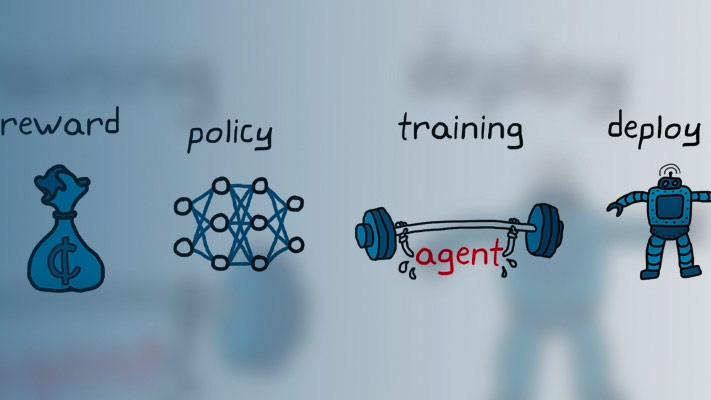Train DQN Agent to Balance Cart-Pole System
This example shows how to train a deep Q-learning network (DQN) agent to balance a cart-pole system modeled in MATLAB®.
For more information on DQN agents, seeDeep Q-Network Agents. For an example that trains a DQN agent in Simulink®, seeTrain DQN Agent to Swing Up and Balance Pendulum.
Cart-Pole MATLAB Environment
The reinforcement learning environment for this example is a pole attached to an unactuated joint on a cart, which moves along a frictionless track. The training goal is to make the pole stand upright without falling over.

For this environment:
The upward balanced pole position is
0radians, and the downward hanging position ispiradians.The pole starts upright with an initial angle between –0.05 and 0.05 radians.
The force action signal from the agent to the environment is from –10 to 10 N.
The observations from the environment are the position and velocity of the cart, the pole angle, and the pole angle derivative.
The episode terminates if the pole is more than 12 degrees from vertical or if the cart moves more than 2.4 m from the original position.
A reward of +1 is provided for every time step that the pole remains upright. A penalty of –5 is applied when the pole falls.
For more information on this model, seeLoad Predefined Control System Environments.
Create Environment Interface
Create a predefined environment interface for the system.
env = rlPredefinedEnv("CartPole-Discrete")
env = CartPoleDiscreteAction with properties: Gravity: 9.8000 MassCart: 1 MassPole: 0.1000 Length: 0.5000 MaxForce: 10 Ts: 0.0200 ThetaThresholdRadians: 0.2094 XThreshold: 2.4000 RewardForNotFalling: 1 PenaltyForFalling: -5 State: [4x1 double]
The interface has a discrete action space where the agent can apply one of two possible force values to the cart, –10 or 10 N.
Get the observation and action specification information.
obsInfo = getObservationInfo(env)
obsInfo = rlNumericSpec with properties: LowerLimit: -Inf UpperLimit: Inf Name: "CartPole States" Description: "x, dx, theta, dtheta" Dimension: [4 1] DataType: "double"
actInfo = getActionInfo(env)
actInfo = rlFiniteSetSpec with properties: Elements: [-10 10] Name: "CartPole Action" Description: [0x0 string] Dimension: [1 1] DataType: "double"
Fix the random generator seed for reproducibility.
rng(0)
Create DQN Agent
A DQN agent approximates the long-term reward, given observations and actions, using a value-function critic.
DQN agents can use multi-output Q-value critic approximators, which are generally more efficient. A multi-output approximator has observations as inputs and state-action values as outputs. Each output element represents the expected cumulative long-term reward for taking the corresponding discrete action from the state indicated by the observation inputs.
To create the critic, first create a deep neural network with one input (the 4-dimensional observed state) and one output vector with two elements (one for the 10 N action, another for the –10 N action). For more information on creating value-function representations based on a neural network, seeCreate Policy and Value Function Representations.
dnn = [ featureInputLayer(obsInfo.Dimension(1),'Normalization','none','Name','state') fullyConnectedLayer(24,'Name','CriticStateFC1') reluLayer('Name','CriticRelu1') fullyConnectedLayer(24,'Name','CriticStateFC2') reluLayer('Name','CriticCommonRelu') fullyConnectedLayer(length(actInfo.Elements),'Name','output')];
View the network configuration.
figure plot(layerGraph(dnn))

Specify some training options for the critic representation usingrlRepresentationOptions.
criticOpts = rlRepresentationOptions('LearnRate',0.001,'GradientThreshold',1);
Create the critic representation using the specified neural network and options. For more information, seerlQValueRepresentation.
critic = rlQValueRepresentation(dnn,obsInfo,actInfo,'Observation',{'state'},criticOpts);
To create the DQN agent, first specify the DQN agent options usingrlDQNAgentOptions.
agentOpts = rlDQNAgentOptions(...'UseDoubleDQN',false,...'TargetSmoothFactor',1,...'TargetUpdateFrequency',4,...'ExperienceBufferLength',100000,...'DiscountFactor',0.99,...'MiniBatchSize',256);
Then, create the DQN agent using the specified critic representation and agent options. For more information, seerlDQNAgent.
agent = rlDQNAgent(critic,agentOpts);
Train Agent
To train the agent, first specify the training options. For this example, use the following options:
Run one training session containing at most 1000 episodes, with each episode lasting at most 500 time steps.
Display the training progress in the Episode Manager dialog box (set the
Plotsoption) and disable the command line display (set theVerboseoption tofalse).Stop training when the agent receives an moving average cumulative reward greater than 480. At this point, the agent can balance the cart-pole system in the upright position.
For more information, seerlTrainingOptions.
trainOpts = rlTrainingOptions(...'MaxEpisodes',1000,...'MaxStepsPerEpisode',500,...'Verbose',false,...“阴谋”,'training-progress',...'StopTrainingCriteria','AverageReward',...'StopTrainingValue',480);
You can visualize the cart-pole system can be visualized by using theplotfunction during training or simulation.
plot(env)

Train the agent using thetrainfunction. Training this agent is a computationally intensive process that takes several minutes to complete. To save time while running this example, load a pretrained agent by settingdoTrainingtofalse. To train the agent yourself, setdoTrainingtotrue.
doTraining = false;ifdoTraining% Train the agent.trainingStats = train(agent,env,trainOpts);else% Load the pretrained agent for the example.load('MATLABCartpoleDQNMulti.mat','agent')end

Simulate DQN Agent
To validate the performance of the trained agent, simulate it within the cart-pole environment. For more information on agent simulation, seerlSimulationOptionsandsim. The agent can balance the cart-pole even when the simulation time increases to 500 steps.
simOptions = rlSimulationOptions('MaxSteps',500); experience = sim(env,agent,simOptions);

totalReward = sum(experience.Reward)
totalReward = 500

